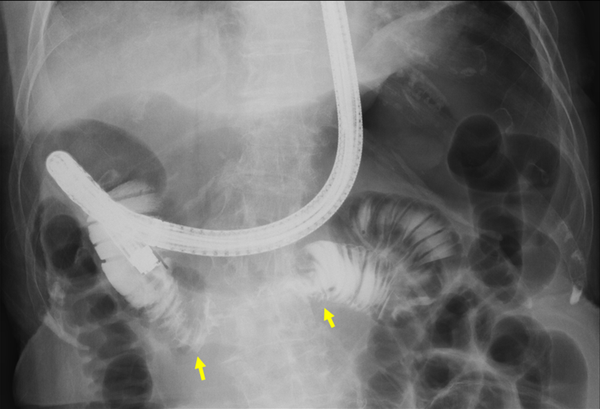-
Home
-
About JCTR
-
Gold Open Access
-
Issues
-
Editorial board
-
Author guidelines
-
Publication fees
-
Online first
-
Special issues
-
News
-
Publication ethics
-
Partners
-
Submit your manuscript
-
Submit your review report
-
Editorial Office
-

This work is licensed under a Creative Commons Attribution-NonCommercial 4.0 International License. ISSN print: 2382-6533 ISSN online: 2424-810X
Volume 7 Issue 5
Endoscopic ultrasonography for preoperative local assessment and endoscopic ultrasonography-guided marking before gastro-jejunostomy for duodenal obstruction using magnetic compression anastomosis
Hideaki Kawabata*, Kojiro Nakase, Yuji Okazaki, Tetsuya Yamamoto, Katsutoshi Yamaguchi, Yuki Ueda, Masatoshi Miyata, Shigehiro Motoi
Kawabata et al. J Clin Transl Res 2021; 7(5):1
Published online: September 20, 2021
Abstract
Background and aim: A 93-year-old woman who was bedridden with severe dementia was referred to our department with a 3-day history of repeated vomiting after meals. CT revealed significant dilatation of the duodenum up to the level of the third portion, which was compressed by a large, low-density mass. Upper GI endoscopy showed narrowing of the third portion of the duodenum with edematous mucosa covered with multiple white spots, where the endoscope was able to pass through with mild resistance. B cell lymphoma was histopathologically suspected from biopsy specimens of the mucosa. We performed gastro-jejunostomy via the magnetic compression anastomosis (MCA) technique. We prepared two neodymium magnets: flat-plate-shaped (15 × 3 mm) with a small hole 3 mm in diameter; a nylon thread was passed through each hole. We then confirmed the absence of no non-target tissue, including large vessels and intestine adjacent to the anastomosis where the magnets were to be placed using endoscopic ultrasonography (EUS) from the stomach. EUS-guided marking using biopsy forceps by biting the mucosa and placing a hemoclip was performed at the anastomosis site in the stomach. The magnet was pushed and delivered to the duodeno-jejuno junction, and another magnet was delivered to the marking point in the stomach. The magnets were attracted towards each other transmurally. The magnets fell into the colon by 11 days after starting the compression, and the completion of gastro-jejunostomy was confirmed.
Relevance for patients: Endoscopic gastro-jejunostomy using MCA is useful as a minimally invasive alternative treatment for duodenal obstruction. EUS for the preoperative local assessment and EUS-guided marking can ensure the safety of the MCA procedure.

DOI: http://dx.doi.org/10.18053/jctres.07.202105.001
Author affiliation
Department of Gastroenterology, Kyoto Okamoto Memorial Hospital, Japan
*Corresponding author
Hideaki Kawabata
Department of Gastroenterology, Kyoto Okamoto Memorial Hospital, 100 Nishinokuchi, Sayama, Kumiyama-cho, Kuze-gun, Kyoto 613-0034, Japan
Tel: +81774 48 5500
Fax: +81774 44 7159
Email: hkawabata@okamoto-hp.or.jp
Handling editor:
Michal Heger
Department of Pharmaceutics, Utrecht University, the Netherlands
Department of Pharmaceutics, Jiaxing University Medical College, Zhejiang, China

